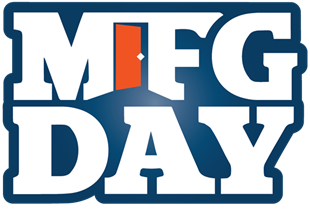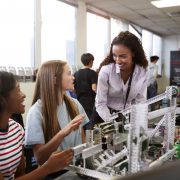Manufacturing Day: Opening Doors and Minds
Manufacturing Day, an initiative of the Manufacturing Institute, is the nation’s largest one-day celebration of manufacturing. This annual event, taking place on October 5, 2018, focuses on showing young people, parents and educators the modern dynamics and opportunities a career in manufacturing offers. For those who can’t make it to a live Manufacturing Day event, or who don’t have any in their area, there’s always the possibility of a virtual event. Learn more about Manufacturing Day and the significant impact this event has across the nation here.
 The National Association of Manufacturers reports job openings in the manufacturing sector hit an all-time high for the 21st Century in July 2018. Manufacturing Day takes on special importance given this growing need for workers. Insights from high school students show how Manufacturing Day can help the US meet the workforce demands for today’s manufacturing.
The National Association of Manufacturers reports job openings in the manufacturing sector hit an all-time high for the 21st Century in July 2018. Manufacturing Day takes on special importance given this growing need for workers. Insights from high school students show how Manufacturing Day can help the US meet the workforce demands for today’s manufacturing.
The Student Research Foundation’s (SRF) most recently completed annual (2017-18) survey of 41,088 high school students in CTE classrooms across the nation found:
- Student interest in manufacturing careers has increased with promises to revive the sector.
- CTE students who have contact with industry professionals report greater benefits from CTE.
- African-American and female students are underrepresented segments who could help meet demand.
Increased appeal of manufacturing careers.
The survey showed manufacturing careers ranked 5th out of 16 career clusters. That is up from 8th place in the 2015-16 survey, possibly reflecting greater political focus on reviving the manufacturing sector.
Real-world experiences benefit students.
Manufacturing Day gives students direct exposure to the manufacturing industry and career opportunities. SRF’s survey found students exposed to CTE professionals were more likely to report career benefits from CTE classes than those not exposed. Indeed, seniors who reported contacts with industry professionals were more likely than their peers with no contacts to say:
- They planned to pursue a career in the CTE field they are studying (48% vs. 30%).
- They had a clearer sense of their career pathway due to CTE (53% vs. 29%).
Expanding the Manufacturing Workforce.
Manufacturing Day could help expand the manufacturing workforce by reaching the two groups of CTE students less likely to aspire to manufacturing careers: African-Americans and women. Among the 2017-18 sample of CTE students:
- 10% of African-Americans aspire to manufacturing, compared with 15% of all others.[1]
- 3% of females aspire to manufacturing, compared with 23% of men.
Boosting interest in manufacturing careers among women and African-Americans may depend on more than simply providing contacts with industry professionals. They already have that, for among the cross-section of high school students in CTE classrooms:
- Females were only slightly more likely than males to have no contact with field professionals (36% vs. 32%).
- African-Americans were marginally less likely than their peers have no contact with field professionals (35% vs. 37%).[2]
Conclusion. Groups less interested in manufacturing need more than simply contact with industry professionals. They need contacts that increase appeal of careers in the industry. Manufacturing Day is an opportunity to do this by: casting the net widely in shaping the program to attract to a broad array of CTE students; reaching middle school students who are deciding which career pathway to follow; and showcasing talented female or African-American workers for all CTE students and faculty to see.
[1] Breaking out the “all other” category, 15% of Native Americans, Whites, and Asians aspire to a manufacturing career. Fourteen percent of Hispanics aspire to manufacturing careers.
[2] Reports of “no contact” with field professionals among the entire cross-section of CTE students range from 32% among Middle Eastern and 33% among Native Americans to 38% among Whites and Hispanics and 40% among Asians.










Leave a Reply
Want to join the discussion?Feel free to contribute!